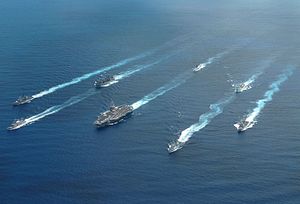The Center for International Maritime Security (CIMSEC) recently hosted an excellent Air-Sea Battle week on its Next War blog, which featured some great analyses that really help crystallize the issues undergirding the ongoing debate over U.S. military strategy in the Pacific. Notably, many of the contributors traced the historical evolution of ASB and anti-access/area denial (A2/AD), or otherwise drew heavily on history to enlighten the current debate. This is quite useful as discussions on these issues often suffer from a dearth of historical perspective.
I found Jeremey Renken’s primer on “five strategic architectures [that] can be applied to U.S.-China confrontation” to be particularly useful. As usual, I was also drawn to T.X. Hammes’s superb analysis, particularly his warnings (based on history) of the danger of adopting an operational concept without a strategy. Far less notably, your humble Pacific Realist also contributed a piece to the debate.
Earlier this week, War on the Rock’s Ryan Evans sat down with a distinguished group of scholars to discuss contemporary nuclear strategy, a topic that simply does not receive enough attention in the public sphere. Here’s the podcast.
Speaking of nuclear strategy, Defense One notes that support in the U.S. for developing a new intercontinental ballistic missile (ICBM) has plunged recently. As the article notes, part of the reason for this declining support can be traced to this fascinating report from the RAND Corporation.
Over at the Belfer Center’s “Iran Matters” website, Annie Tracy Samuel seeks to correct some common misconceptions about the Islamic Revolutionary Guard Corps’ (IRGC) position on the Iran-P5+1 nuclear talks. Similarly, Real Clear World’s Greg Scoblete and the American Conservative’s Daniel Larson seek to correct House Majority Leader Rep. Eric Cantor’s (R-VA) absurd claims about how a nuclear-armed Iran would operate.
Over at APSI’s The Strategist, Karl Claxton examines China’s interests and evolving capabilities in the South Pacific. He concludes that: “While there’s no need to hyperventilate, China’s growing reach does complicate our strategic calculus. Scenarios that seemed outlandish a few years ago, such as the PLA evacuating its nationals if they were targeted in civil strife, while still unlikely, no longer seem so far-fetched and will soon be technically feasible.”
Time magazine has an exclusive interview with the Dalai Lama, who met with President Obama today and is about to embark on a tour of the Western Coast of the United States. The interview is conducted by Time’s religion reporter, Elizabeth Dias, and the subject matters are wide ranging. I was drawn to Dias’ last question, asking the Dali Lama about his views of President Xi Jinping, in response to which the Dalai Lama began by saying, “He is courageously tackling corruption, quite effectively. Fearlessly.”
In my last links piece a few weeks back, I noted that Ashley Tellis would soon be publishing a report entitled: Balancing Without Containment: An American Strategy for Managing China. The report has now been published by the Carnegie Endowment for International Peace, and can be read here.
Finally, for “new book watch:”
CFR’s Elizabeth Economy and Michael Levi released a book earlier this month on the global implications of China’s demand for natural resources.
David Lampton has a new book out on China’s top leaders from Deng Xiaoping to Xi Jinping.
And AEI’s Michael Rubin published a book this week analyzing America’s attempts to negotiate with rogue regimes over the last half century.
Disclaimer: I haven’t had a chance to read any of these books yet (though I’ve started the Economy and Levi). I therefore cannot vouch for their quality. That being said, are all on important topics and written by thoughtful scholars, even if I disagree with some of them on a number of issues.
































